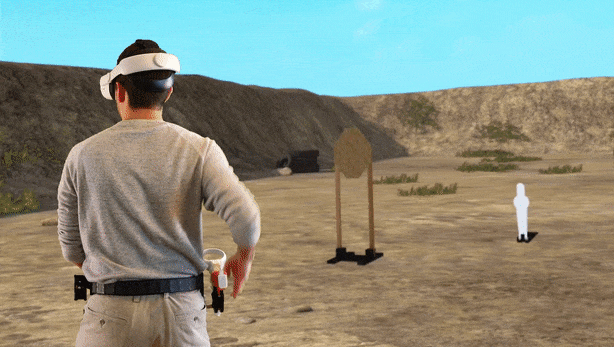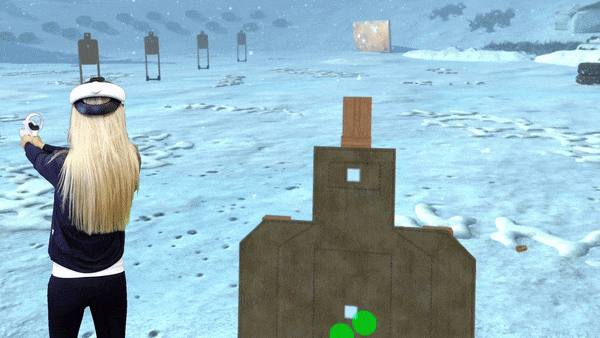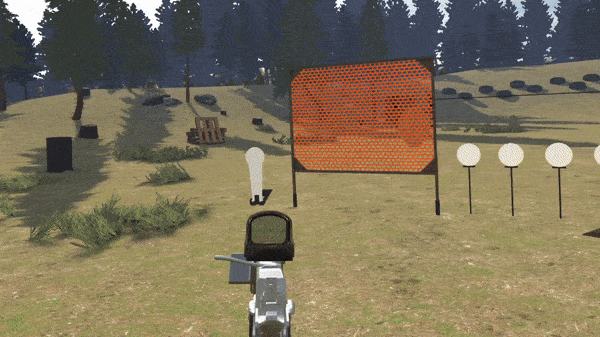Developing Shooting Skills: Accuracy, Transitions, and Speed
If you are new to shooting, Ace wants to help you improve. Every skill starts with a solid foundation. They build with perfect practice. For handgun training and proficiency, the three basics to practice are accuracy, transitions, and speed - in that order.
These three fundamentals are important for any scenario - home or property defense, everyday carry, a backwoods bear encounter, or just a fun competitive day with your friends at the shooting range.
Like building blocks - each skill builds on the one before it. Speed doesn’t matter if you lack accuracy, so we’ll start there.
Accuracy: Precision in Every Shot
Ace believes that firearms safety is critical. It is everyone’s responsibility. Whether on the range or otherwise, you are responsible for every live fire shot you take and where that bullet ends up. While Ace does not involve real guns or bullets, it can reinforce good habits and improve accuracy. Let’s look at the practical components to improving your accuracy with a handgun.
Proper Grip and Stance
Getting the right, firm grip on your gun is step number one. Ensure your shots are steady as you squeeze, not pull, the trigger. Focus on getting many points of contact between your hands and the pistol grip and frame. Frequent use with the Ace Handset will help make a proper grip feel more natural and comfortable over time.
Sight Alignment and Finding the Dot
Whether you’re using iron sights or a red dot, the premise is the same: with consistent practice, you should be able to present from a low-ready position and line up your sites (or find your dot) quickly. Keep your eyes focused on the target down range, while you move your gun into alignment. Keep your head steady and move the gun to your view. Drawing your handset in Ace helps build this muscle memory of sight alignment or finding the dot in the Ace VR App.
Trigger Control: Squeeze, Don’t Pull
People new to shooting often find that most of their shots are low and to the left of where they aimed. This is usually caused by anticipation of recoil, and / or jerking the trigger. Getting more dry fire reps or using Ace, where there is no recoil, can help develop the habit of not focusing on the recoil. This repetition will help your shots stay on target. As you pull the trigger, focus on pulling your finger backwards steadily. As you do this you almost let the shot surprise you when it breaks.
Practice, Practice, Practice
Using a dry fire training system like Ace helps develop consistent, repeatable, muscle memory. This system allows you to get thousands of reps in without spending a large amount of money on ammo. Both the Ace Arctus and the Ace Staccato P handsets have a realistic trigger feel with a 3-4 pound break. Given that it is similar to a carry gun, using the Ace physical handset can provide valuable dry fire training benefits.
Ready to Improve Your Shooting Fundamentals?
Join the Ace Community Today
Transitions: Moving Between Targets
Transitioning between multiple targets in a defensive situation requires speed and precision as you shift focus. There are two primary ways of transitioning between targets. Novice shooters often stop their gun on each target before taking the shot. Experienced shooters, however, are able to move seamlessly between targets without stopping. Let’s look at both.
Stopping on Each Target: This method ensures that you are fully focused and steady before taking each shot. It can be useful for ensuring precision and accuracy, especially if the targets are at different distances. Become proficient at stopping on each target and taking accurate shots before working on seamless transitions.
Seamless Transitions: With this approach there is no break in motion as your vision moves smoothly over multiple targets. This method can be faster and more useful when encountering multiple targets at close range. As you take the last shot on one target, your eye should shift focus to the next target as you move the gun to aim. Do not try to keep your eyes solely focused on your sights (red dot or iron sights) as you move through the transition but rather let your eyes move ahead.
In many cases, it will be more effective to start with the targets closer to you and move to the ones further away. Regardless, in all cases move between targets in a way that requires the least movement between each one.
Speed: Getting There Faster
Everyone wants to go faster. If you are running any of the 100+ Drills in Ace, you don’t have to worry about the cost of ammo. Push your speed limits in Ace to learn but beware not to build bad habits in live fire. Master Accuracy and Transitions before you try to go fast. Going fast means more than just how quickly you squeeze the trigger.
Drawing from Holster
The first step in shooting faster is drawing faster. Retrieving your handgun from the holstered position as efficiently as possible takes practice of that movement; lifting your shirt if necessary to clear a waistband, getting a firm grasp on the grip, pulling past the holster’s retention, and then presenting and pushing out to acquire the target. Practice this entire motion often (unloaded, of course) with your Ace holster or other compatible hardware.
Finding the Dot (Sight Alignment)
Some red dots are configured to align with the front and rear sights. Other arrangements have the iron sights removed which compels the user to acquire the red dot without the aid of the iron sight posts. Either way, if you struggle to find the dot soon after you draw and present stop and consider some of these likely causes. Very often, the red dot will be “high” and you’ll have to adjust the sight picture down to find the dot. Continue to adjust your presentation so that the dot comes into view more readily. After hundreds of reps practicing and refining your technique, your red dot will more consistently come into view.
Firing the First Shot on Target
In a defensive situation, getting your first shot on target as fast as possible is critical. If you’re practicing live fire at the range, run drills where you’re only taking one shot at a time, then reholstering, and running again. If you’re practicing with Ace, look down at the PACT timer to see your time to first shot. As you are getting started, aim for getting your draw and time to first shot under 2 seconds.
Reloading a Magazine
To increase reload speed, make it a habit of inserting loaded spare mags in a pouch the same way every time - preferably with bullets facing forwards. When grabbing the new mag, align your index finger down the front spine of the mag as you pull it out of the pouch. Rotate your hand as you bring the mag to the gun so it is ready to be slammed into the gun. Just like the practice of drawing from a holster and finding the dot, practice reps with empty mags will aid in acquiring muscle memory.
Hopefully this guide provided practical tips for improving on the fundamentals of shooting. Click below to learn how Ace can accelerate your training with VR drills and unlimited virtual ammo.






